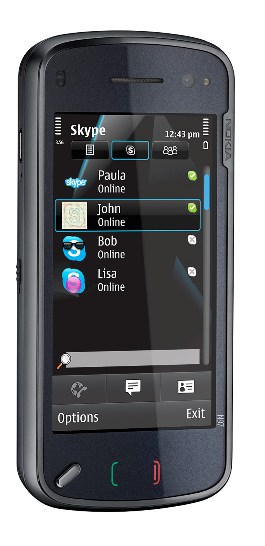 Skype is (finally) teaming up with mobile handset maker Nokia to get its VoIP and IM software program pre-installed on some of Nokia’s devices, as announced at the Mobile World Congress and reported by MobileCrunch. The eBay-owned company had 405 million registered users in total at the end of last year, and Nokia is still the largest handset maker in the world until further notice, so this is a significant deal.
Skype is (finally) teaming up with mobile handset maker Nokia to get its VoIP and IM software program pre-installed on some of Nokia’s devices, as announced at the Mobile World Congress and reported by MobileCrunch. The eBay-owned company had 405 million registered users in total at the end of last year, and Nokia is still the largest handset maker in the world until further notice, so this is a significant deal.
Of course, the operators won’t be jumping up and down from joy over the news.
The first Nokia device to get the Skype integration will be the N97, beginning in Q3 of 2009, followed by (unnamed but reportedly high-end) N-series devices. Leveraging N97’s WiFi and 3G connectivity, users will be able to communicate with Skype-to-Skype voice calls, as well as make mobile and landline Skype calls at reasonable prices. We should note that Sony Ericsson already has some sort of solution for Skype by offering a ‘panel’ for the app on its Xperia X1 device (which runs Windows Mobile 6.1), and Skype already had a mobile ‘lite’ version in beta which works fine on compatible LG, Motorola, Nokia, Samsung and Sony Ericsson phones.
Bringing Skype’s internet calling app on-board is one thing, but I am more excited about the presence management. The fact that the application will tap into your contact list to see who else is online or not, and enable you to chat with your friends and co-workers either by voice or text instantly, is a powerful feature.
But what does this mean for those mobile VoIP startups for whom one of the prime reasons of existence in the first place is supporting Skype functionality on mobile handsets, like fring, Nimbuzz and Truphone?
I got in touch with executives at all three startups to get a reaction on the news. Unsurprisingly, they call the move a validation of their services and are confident they won’t be pushed aside any time soon.
Tobias Kemper, Head of Communications at Nimbuzz, says the fact that Skype will come pre-installed on mobile devices is actually going to help normalize the use of VoIP applications (and particularly Skype) and thus boost their own growth. He also added that the integrated approach of Nimbuzz, which combines a variety of voice and text chat services into one app, is still in demand.
Geraldine Wilson, CEO of Truphone, says much of the same by declaring that this will only increase the awareness and uptake of these kinds of VoIP applications on mobile, which is good for Truphone too. She also cites the interoperability with Skype in combination with support for other communication services to be a big advantage for their users.
I’ll update this post with fring’s view as soon as it gets in, but you should also read up on what iSkoot is doing by moving beyond Skype for mobile phones with the release of a more general application.
I agree that bringing Skype to a select number of Nokia devices isn’t going to ‘kill’ any of the service providers I mentioned, and the aggregation of communication services is still a very good selling point in a world were people are connected through multiple social networks and instant messaging clients. That said, for the VoIP part it won’t get any better than having Skype pre-installed on a phone that links up your contacts to the application instantly. While companies like fring, Nimbuzz and Truphone are scrambling to turn their fast-growing legion of users into a profitable business, Skype has more runtime and more leverage to push free internet calling to mobile phone users.
But as I mentioned before, the carriers are not going to be happily standing on the sidelines as things progress.